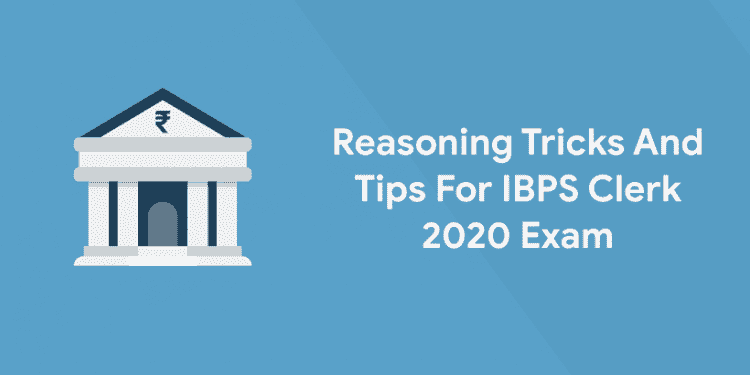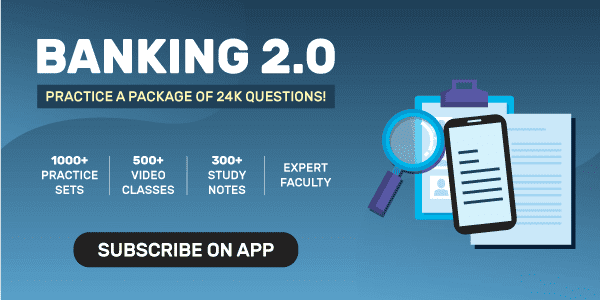These days reasoning ability questions are becoming an inevitable part of every competitive exams, be it SSC, PSC or banking exams. It tests your ability to think in a logical and sensible manner. If you are good at solving reasoning questions, then you have good chance of scoring well, which is in fact easy to do if you know the right tricks. So, this article will be about reasoning tips and tricks for IBPS Clerk 2020 exam.
Attempt IBPS Clerk mock tests! Download App Now!
Reasoning questions are of four types:
- Verbal reasoning
- Non-verbal reasoning
- Analytical reasoning
- Logical reasoning
Reasoning Tips and Tricks for IBPS Clerk 2020
Verbal reasoning
Majority of the questions in reasoning comes from this part. It checks your skill in understanding the concepts of framed words and accesses your comprehensive skills. Verbal reasoning includes the following topics:
a) Blood relations
These types of questions will be about family relationships. The question will be about finding the relation between two or more people from a given set of information. The trick is to remember the name of the relation. When you get a question, assume the relation with regards to you and find the relationship. If you cannot visualize the relationship in mind, then draw a family tree chart using the details given in the question.
Practice Blood Relations Questions here
b) Coding-decoding
Coding is a technique used when two people want to communicate with out others recognizing the message. It is a combination of letters, numbers and symbols. The different types of coding include:
Letter coding – Find out the relationship between each letter of the first word to the first letter of the second word. Once you have found the relationship, decode the word in the question by applying this relationship to each word.
Number coding – In these questions a word will be coded as a number series. Each letter will be assigned a number. Assign these numbers to the letters in the word in the question and find out the answer.
Number to letter coding– These are the type of questions in which a number series is equivalent to a word. Each number has a corresponding letter and the logic needs to be found out. Then apply the logic to the numerical series in the question.
Practice Coding Decoding Questions here
c) Data sufficiency
In these problems, two or more statements will be given. We have to find out whether the data is enough or not. Remember, the point is not to find the solution but to just see whether the data given is enough to reach a conclusion.
d) Direction sense
Direction sense questions are about finding the direction of a person with respect to his initial position, distance between his initial and final position etc. Read more to know the tricks and tips by clicking here.
Tricks to solve direction sense questions
e) Logical sequence
These are the questions in which couple of words are given and you have to arrange it in a logical sequence either in the order of happening or backwards.
f) Seating arrangement
These questions require us to deduce the seating position of a couple of people from the given data. The point that you need to keep in mind is whether the individuals are sitting facing inwards or outwards. The left and right direction varies for both the cases.
Tricks to solve Seating arrangement questions
g) Series completion
These questions contain either series of number or alphabet in a logical manner. The trick to help you solve this question is to write down each alphabet along with its position number, say A will be 1, B will be 2 and so on.
Practice Number Series questions here
Non-verbal reasoning
Non-verbal reasoning analyses your skills in understanding and analyzing visual information.
The different types of non-verbal reasoning include:
a) Analogy
Analogy means comparison between two things. The question is to find the image that looks similar to the image in the question.
Click here to attempt Analogy questions
b) Water images
Here we are supposed to find the reflection of a said image. Keep in mind that the image of the object will be upside down but the sides wont change. Left will be on the left side of the reflection and whatever is on the right of the image will be on right side.
c) Paper folding
These questions check your ability to keep track of the changes in the shape as per the instructions. The question includes a sheet of paper turned in a certain order while cuts are made with each turn. The task is to figure out the way the paper will look like at the end of folding.
d) Mirror images
Mirror image refers to the reflection of an object on the mirror. In this case, the image and the object will be reverse order. What is on the left side of the object will be on the right side of the image. What is on the right side will be on the left side.
e) Cube and dice
Remember the following points: A cube has 6 square faces or sides. It has 8 points. A cube has 12 edges. Only 3 sides of a cube are seen at a time. There are certain rules that needs to memorized:
Rule 1 – Two opposite faces of the dice cannot be adjacent to each other.
2 – If two dice are such that the same number appear on top, and one of the two common faces is in the same position, then the remaining faces will be opposite to each other.
3 – If in 2 different positions of the dice, the positions (different), the position of the face that’s common is the same, and then the opposite faces of the faces that remain will be in the same positions
4 – If 2 positions of a die are given (Different) and it is also stated that common face is different then the face opposite to the given common face would be that which is not shown on any given face in the 2 given positions. It is also to be noted that the opposite face of the faces that are left cannot be the same.
Analytical reasoning
a) Inequalities
In these questions, couple of statements containing a group of elements will be given. These elements will be having a certain relationship among them which is denoted by different inequalities symbols like >, < , = etc.
Easy tricks to solve Inequality questions
b) Syllogism
This is the type of question in which few statements will be given and you have to find out whether the given conclusions are correct. This can be done using Venn diagram. Draw the circles as per the statements and reach the conclusion based on the figure. Check whether the conclusions are the same as that given in question and answer accordingly.
Tricks to solve Syllogism questions
Logical reasoning
a) Cause and effect
In this type of question, the main aim of cause and effect questions is to find the relationship between two statements. We have to find out whether statements are related to each other. So, we have to find out whether the statement is the cause of the other.
Practice Cause and Effect Problems here
b) Statement – courses of action
In this type of questions, a statement will be given along with two courses of action. Candidate must read the statement and decide whether the course of action follows the given statement.
Tips to solve statement and conclusion problems
Ace your exam preparation with the help of Entri app












